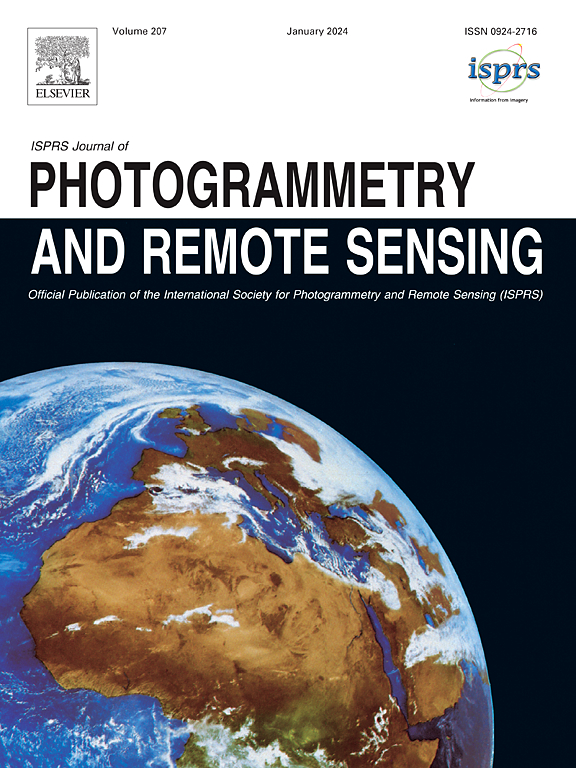Mapping the Brazilian savanna’s natural vegetation: A SAR-optical uncertainty-aware deep learning approach
IF 10.6
1区 地球科学
Q1 GEOGRAPHY, PHYSICAL
ISPRS Journal of Photogrammetry and Remote Sensing
Pub Date : 2024-09-26
DOI:10.1016/j.isprsjprs.2024.09.019
引用次数: 0
Abstract
The Brazilian savanna (Cerrado) is considered a hotspot for conservation. Despite its environmental and social importance, the biome has suffered a rapid transformation process due to human activities. Mapping and monitoring the remaining vegetation is essential to guide public policies for biodiversity conservation. However, accurately mapping the Cerrado’s vegetation is still an open challenge. Its diverse but spectrally similar physiognomies are a source of confusion for state-of-the-art (SOTA) methods. This study proposes a deep learning model to map the natural vegetation of the Cerrado at the regional to biome level, fusing Synthetic Aperture Radar (SAR) and optical data. The proposed model is designed to deal with uncertainties caused by the different resolutions of the input Sentinel-1/2 images (10 m) and the reference data, derived from Landsat images (30 m). We designed a multi-resolution label-propagation (MRLP) module that infers maps at both resolutions and uses the class scores from the 30 m output as features for the 10 m classification layer. We train the model with the proposed calibrated dual focal loss function in a 2-stage hierarchical manner. Our results reached an overall accuracy of 70.37%, representing an increase of 15.64% compared to a SOTA random forest (RF) model. Moreover, we propose an uncertainty quantification method, which has shown to be useful not only in validating the model, but also in highlighting areas of label noise in the reference. The developed codes and dataset are available on Github.
绘制巴西热带草原自然植被图:合成孔径雷达-光学不确定性感知深度学习方法
巴西热带稀树草原(Cerrado)被认为是保护的热点地区。尽管在环境和社会方面具有重要意义,但由于人类活动的影响,该生物群落已经历了快速的转变过程。绘制和监测剩余植被对于指导保护生物多样性的公共政策至关重要。然而,准确绘制 Cerrado 的植被图仍然是一个公开的挑战。植被种类繁多,但光谱相似,这给最先进的(SOTA)方法带来了困惑。本研究提出了一种深度学习模型,通过融合合成孔径雷达(SAR)和光学数据,绘制从区域到生物群落级别的塞拉多自然植被图。所提议的模型旨在处理因输入的 Sentinel-1/2 图像(10 米)和从 Landsat 图像(30 米)得出的参考数据的分辨率不同而造成的不确定性。我们设计了一个多分辨率标签传播(MRLP)模块,该模块可推导出两种分辨率的地图,并将 30 米输出的类别得分作为 10 米分类层的特征。我们采用所提出的校准双焦点损失函数,以两阶段分层方式对模型进行训练。我们的结果达到了 70.37% 的总体准确率,与 SOTA 随机森林 (RF) 模型相比提高了 15.64%。此外,我们还提出了一种不确定性量化方法,结果表明该方法不仅有助于验证模型,还能突出参考文献中存在标签噪声的区域。开发的代码和数据集可在 Github 上获取。
本文章由计算机程序翻译,如有差异,请以英文原文为准。
求助全文
约1分钟内获得全文
求助全文
来源期刊

ISPRS Journal of Photogrammetry and Remote Sensing
工程技术-成像科学与照相技术
CiteScore
21.00
自引率
6.30%
发文量
273
审稿时长
40 days
期刊介绍:
The ISPRS Journal of Photogrammetry and Remote Sensing (P&RS) serves as the official journal of the International Society for Photogrammetry and Remote Sensing (ISPRS). It acts as a platform for scientists and professionals worldwide who are involved in various disciplines that utilize photogrammetry, remote sensing, spatial information systems, computer vision, and related fields. The journal aims to facilitate communication and dissemination of advancements in these disciplines, while also acting as a comprehensive source of reference and archive.
P&RS endeavors to publish high-quality, peer-reviewed research papers that are preferably original and have not been published before. These papers can cover scientific/research, technological development, or application/practical aspects. Additionally, the journal welcomes papers that are based on presentations from ISPRS meetings, as long as they are considered significant contributions to the aforementioned fields.
In particular, P&RS encourages the submission of papers that are of broad scientific interest, showcase innovative applications (especially in emerging fields), have an interdisciplinary focus, discuss topics that have received limited attention in P&RS or related journals, or explore new directions in scientific or professional realms. It is preferred that theoretical papers include practical applications, while papers focusing on systems and applications should include a theoretical background.
 求助内容:
求助内容: 应助结果提醒方式:
应助结果提醒方式:


